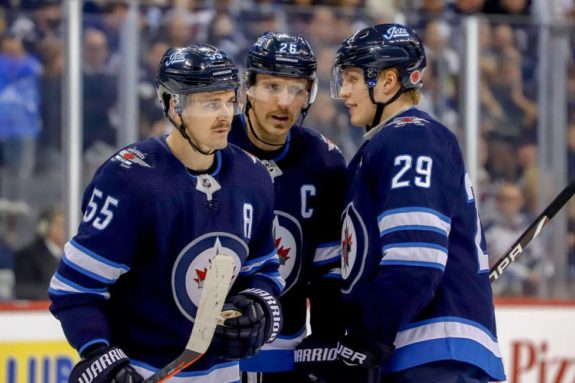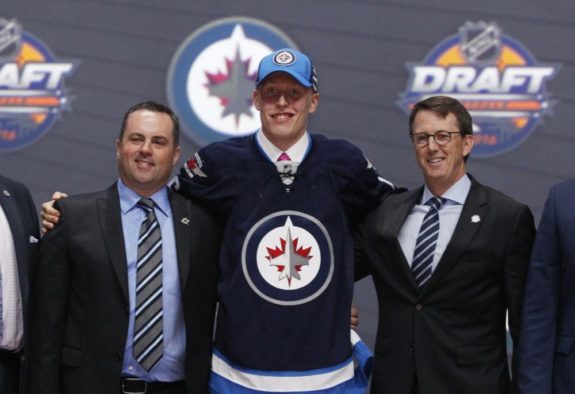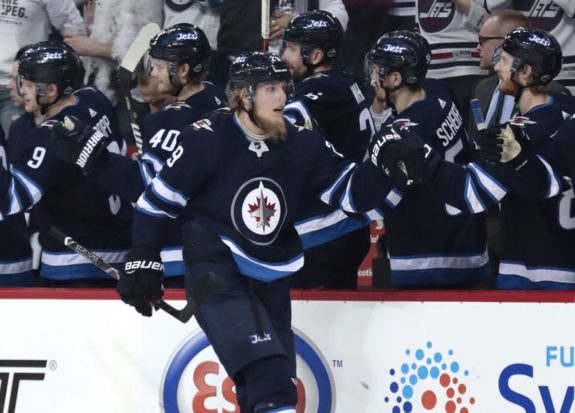Patrik Laine scored 30 goals in what should be considered a down-year during the 2018-19 season. The three-year veteran has no idea what it’s like to score fewer than 30 goals in the National Hockey League. It’s easy to be happy with a 30-goal scorer, but Laine’s 2018-19 production just wasn’t what we had become accustomed to seeing.
Laine’s Down Season
He scored only 15 goals, placing him 100th out of 161 players who played at least 1000 minutes, at even-strength. He netted 24 goals in 2017-18, which was good enough for 23rd out of 159 players. In 2016-17, he scored 27 and finished seventh in the league out of 155 players.
You could be pessimistic and see this as a downward trend and a cause for concern, or you could take last season as an off-year for a 21-year-old player. The latter is currently a better route to take given the talent level that Laine has and his ability to score goals.
Related: 5 Greatest Moments in Jets 2.0 History
If we look at goals-per-60 at even-strength, Laine is impressive. He’s a top-15 player in this category in his second season and was a top-five player in his rookie season. It’s highly improbable a player accidentally finds himself in the top-15 in back-to-back seasons, only to never see high-end numbers again. He hasn’t made much of a case to realistically challenge Auston Matthews in the ‘who’s better’ debate since they were drafted, but you could argue he is still an elite goal scorer right now.

The issue with Laine, and it’s less impactful because of his shooting percentages (which we’ll get to shortly), is that he does not drive play. He’s an elite goal scorer who can get himself open and finish, but he relies on his linemates to create chances and find him on the ice. For the majority of his 5-on-5 time over the first three seasons of his career, his lines have struggled to generate shot attempts at the opposite end of the ice.
He has spent (individually with each) 1,415 minutes with Bryan Little, 845 minutes with Mark Scheifele, and 223 minutes with Paul Stastny. Without any of them, he has spent 664 minutes. Nearly 68 percent of his time (around 3,334 TOI) was spent with Little or Scheifele, where he helped them be a very ineffective group compared to when they didn’t have Laine with them.
His major underlying success came when he was with Paul Stastny, albeit only for a meager percentage of time (around 6.7 percent of his total 5-on-5 time over the past three seasons). He and Stastny were able to generate a 6.01 CF/60 relative, which is significantly higher than the minus-4.6 and minus-3.75 he boasts with Little and Scheifele, respectively.
When he isn’t with any of the aforementioned players, he becomes almost perfectly average with a 0.12 CF/60 relative. The defensive side of his game remains inadequate regardless of who he plays with, but that can become almost completely forgivable if he can start to establish some puck control chemistry with some of his teammates – or if he goes back to scoring 30 to 40 goals every season.

The Selling Point Has Always Been Goals
The selling point for Laine – and one that had some people pondering his value on draft day being higher than Matthews’ – was always that he scores goals. That part hasn’t changed, and it’s not likely to for quite some time. Over the past three seasons, Laine ranks sixth in total goals with 110. The five players above him are Alex Ovechkin, Nikita Kucherov, Connor McDavid, John Tavares, and Auston Matthews.
It’s safe to say that Laine has established himself as a player that the opposition fears when he’s on the ice. He might not be the primary driver of play, but he finishes. That’s important for the Jets to consider in contract negotiations, especially with the rumors surrounding Laine’s potential departure. That’s a scenario that the Jets cannot let happen.
Simply put, players who score 30 goals regularly don’t fall out of the sky. The 2018-19 season saw Laine record his lowest shooting percentage to date in the NHL. His 12.2 percent is just 0.4 percent below Ovechkin’s career average, though he (Laine) managed to shoot 17.6 percent and 18.3 percent in his first two seasons. It’s a stretch to assume he can regularly climb back up to the 17.6 to 18.3 percent considering how high that is, but it’s reasonable to apply at least a small uptick for the 2019-20 season.

The Jets, as a whole, saw a drop in their even-strength play last season compared to 2017-18 – which doesn’t help a young player who fails dominate puck possession. If they can turn around their possession numbers even the slightest they’ll be setting Laine up for more success. Combine that with an increase in shooting percentage and you’ve got the recipe for a season that features more of what you would expect from a player like Laine.